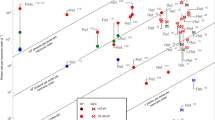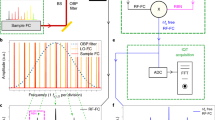Abstract
Optical frequency combs1 act as rulers in the frequency domain and have opened new avenues in many fields such as fundamental time metrology, spectroscopy and frequency synthesis. In particular, spectroscopy by means of optical frequency combs has surpassed the precision and speed of Fourier spectrometers. Such a spectroscopy technique is especially relevant for the mid-infrared range, where the fundamental rotational–vibrational bands of most light molecules are found2. Most mid-infrared comb sources are based on down-conversion of near-infrared, mode-locked, ultrafast lasers using nonlinear crystals3. Their use in frequency comb spectroscopy applications has resulted in an unequalled combination of spectral coverage, resolution and sensitivity4,5,6,7. Another means of comb generation is pumping an ultrahigh-quality factor microresonator with a continuous-wave laser8,9,10. However, these combs depend on a chain of optical components, which limits their use. Therefore, to widen the spectroscopic applications of such mid-infrared combs, a more direct and compact generation scheme, using electrical injection, is preferable. Here we present a compact, broadband, semiconductor frequency comb generator that operates in the mid-infrared. We demonstrate that the modes of a continuous-wave, free-running, broadband quantum cascade laser11 are phase-locked. Combining mode proliferation based on four-wave mixing with gain provided by the quantum cascade laser leads to a phase relation similar to that of a frequency-modulated laser. The comb centre carrier wavelength is 7 micrometres. We identify a narrow drive current range with intermode beat linewidths narrower than 10 hertz. We find comb bandwidths of 4.4 per cent with an intermode stability of less than or equal to 200 hertz. The intermode beat can be varied over a frequency range of 65 kilohertz by radio-frequency injection. The large gain bandwidth and independent control over the carrier frequency offset and the mode spacing open the way to broadband, compact, all-solid-state mid-infrared spectrometers.
This is a preview of subscription content, access via your institution
Access options
Subscribe to this journal
Receive 51 print issues and online access
$199.00 per year
only $3.90 per issue
Buy this article
- Purchase on Springer Link
- Instant access to full article PDF
Prices may be subject to local taxes which are calculated during checkout



Similar content being viewed by others
References
Udem, T., Holzwarth, R. & Hänsch, T. W. Optical frequency metrology. Nature 416, 233–237 (2002)
Keilmann, F., Gohle, C. & Holzwarth, R. Time-domain mid-infrared frequency-comb spectrometer. Opt. Lett. 29, 1542–1544 (2004)
Adler, F. et al. Phase-stabilized, 1.5 W frequency comb at 2.8–4.8 µm. Opt. Lett. 34, 1330–1332 (2009)
Johnson, T. A. & Diddams, S. A. Mid-infrared upconversion spectroscopy based on a Yb:fiber femtosecond laser. Appl. Phys. B 107, 31–39 (2012)
Foltynowicz, A., Ban, T., Masłowski, P., Adler, F. & Ye, J. Quantum-noise-limited optical frequency comb spectroscopy. Phys. Rev. Lett. 107, 233002 (2011)
Adler, F., Thorpe, M. J., Cossel, K. C. & Ye, J. Cavity-enhanced direct frequency comb spectroscopy: technology and applications. Annu. Rev. Anal. Chem. 3, 175–205 (2010)
Vodopyanov, K. L., Sorokin, E., Sorokina, I. T. & Schunemann, P. G. Mid-IR frequency comb source spanning 4.4–5.4 µm based on subharmonic GaAs optical parametric oscillator. Opt. Lett. 36, 2275–2277 (2011)
Del’Haye, P. et al. Optical frequency comb generation from a monolithic microresonator. Nature 450, 1214–1217 (2007)
Wang, C. Y. et al. Mid-infrared optical frequency combs based on crystalline microresonators. Preprint at http://arxiv.org/abs/1109.2716 (2011)
Kippenberg, T. J., Holzwarth, R. & Diddams, S. A. Microresonator-based optical frequency combs. Science 332, 555–559 (2011)
Faist, J. et al. Quantum cascade laser. Science 264, 553–556 (1994)
Derickson, D. J. et al. Short pulse generation using multisegment mode-locked semiconductor lasers. IEEE J. Quantum Electron. 28, 2186–2202 (1992)
Wang, C. Y. et al. Mode-locked pulses from mid-infrared quantum cascade lasers. Opt. Express 17, 12929–12943 (2009)
Faist, J. et al. Laser action by tuning the oscillator strength. Nature 387, 777–782 (1997)
Barbieri, S. et al. Coherent sampling of active mode-locked terahertz quantum cascade lasers and frequency synthesis. Nature Photon. 5, 306–313 (2011)
Del’Haye, P., Arcizet, O., Schliesser, A., Holzwarth, R. & Kippenberg, T. Full stabilization of a microresonator-based optical frequency comb. Phys. Rev. Lett. 101, 053903 (2008)
Ferdous, F. et al. Spectral line-by-line pulse shaping of on-chip microresonator frequency combs. Nature Photon. 5, 770–776 (2011)
Gordon, A. et al. Multimode regimes in quantum cascade lasers: from coherent instabilities to spatial hole burning. Phys. Rev. A 77, 053804 (2008)
Yamada, M. Theoretical analysis of nonlinear optical phenomena taking into account the beating vibration of the electron density in semiconductor lasers. J. Appl. Phys. 66, 81–89 (1989)
Walrod, D., Auyang, S. Y., Wolff, P. A. & Sugimoto, M. Observation of third order optical nonlinearity due to intersubband transitions in AlGaAs/GaAs superlattices. Appl. Phys. Lett. 59, 2932–2934 (1991)
Rosencher, E. et al. Quantum engineering of optical nonlinearities. Science 271, 168–173 (1996)
Banerjee, S. & Shore, K. A. MIR and NIR nonlinear optical processing using intersubband χ(3) in triple quantum well structures. Semicond. Sci. Technol. 18, 655–660 (2003)
Parz, W. et al. Intersubband gain-induced dispersion. Opt. Lett. 34, 208–210 (2009)
Grant, P. D., Dudek, R., Buchanan, M. & Liu, H. C. Room-temperature heterodyne detection up to 110 GHz with a quantum-well infrared photodetector. IEEE Photon. Technol. Lett. 18, 2218–2220 (2006)
Aellen, T. et al. Direct measurement of the linewidth enhancement factor by optical heterodyning of an amplitude-modulated quantum cascade laser. Appl. Phys. Lett. 89, 091121 (2006)
Soibel, A. et al. Active mode locking of broadband quantum cascade lasers. IEEE J. Quantum Electron. 40, 844–851 (2004)
Telle, H. et al. Carrier-envelope offset phase control: a novel concept for absolute optical frequency measurement and ultrashort pulse generation. Appl. Phys. B 69, 327–332 (1999)
Braje, D., Hollberg, L. & Diddams, S. Brillouin-enhanced hyperparametric generation of an optical frequency comb in a monolithic highly nonlinear fiber cavity pumped by a cw laser. Phys. Rev. Lett. 102, 193902 (2009)
Herr, T. et al. Universal formation dynamics and noise of Kerr-frequency combs in microresonators. Nature Photon. 6, 480–487 (2012)
Terazzi, R. & Faist, J. A density matrix model of transport and radiation in quantum cascade lasers. N. J. Phys. 12, 033045 (2010)
Acknowledgements
We thank M. Quack and E. Miloglyadov for their help with the high-resolution Fourier transform infrared spectrometer measurements, U. Keller and V. Wittwer for providing scientific equipment, and J. Khurgin for discussions. This work was financially supported by the Quantum Photonics National Center of Competence in Research of the Swiss National Science Foundation. H.C.L. acknowledges support from the National Major Basic Research Projects (2011CB925603) and the Shanghai Municipal Major Basic Research Project (09DJ1400102).
Author information
Authors and Affiliations
Contributions
A.H. carried out the measurements. Simulations and ideas were developed by A.H. and J.F. G.V. contributed to the heterodyne beat measurements as well as the amplitude noise measurements. S.B. provided both quantum cascade lasers. H.C.L. provided the quantum-well infrared photodetector. All the work was done under the supervision of J.F.
Corresponding authors
Ethics declarations
Competing interests
The authors declare no competing financial interests.
Supplementary information
Supplementary Figures
This file contains Supplementary Figures 1-9. (PDF 1239 kb)
Rights and permissions
About this article
Cite this article
Hugi, A., Villares, G., Blaser, S. et al. Mid-infrared frequency comb based on a quantum cascade laser. Nature 492, 229–233 (2012). https://doi.org/10.1038/nature11620
Received:
Accepted:
Published:
Issue Date:
DOI: https://doi.org/10.1038/nature11620
This article is cited by
-
Active mid-infrared ring resonators
Nature Communications (2024)
-
Nozaki–Bekki solitons in semiconductor lasers
Nature (2024)
-
Photon-trapping-enhanced avalanche photodiodes for mid-infrared applications
Nature Photonics (2023)
-
Broadband quantum-dot frequency-modulated comb laser
Light: Science & Applications (2023)
-
Visible-to-mid-IR tunable frequency comb in nanophotonics
Nature Communications (2023)
Comments
By submitting a comment you agree to abide by our Terms and Community Guidelines. If you find something abusive or that does not comply with our terms or guidelines please flag it as inappropriate.



